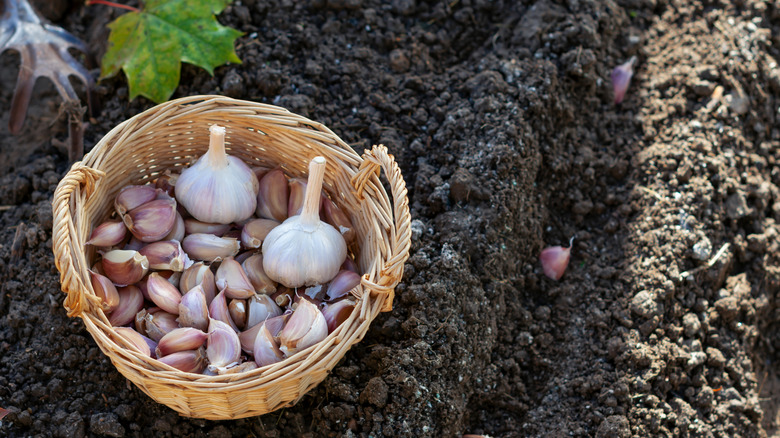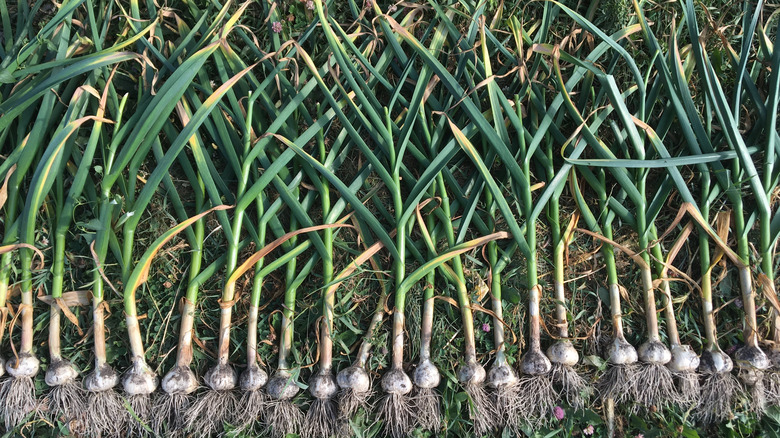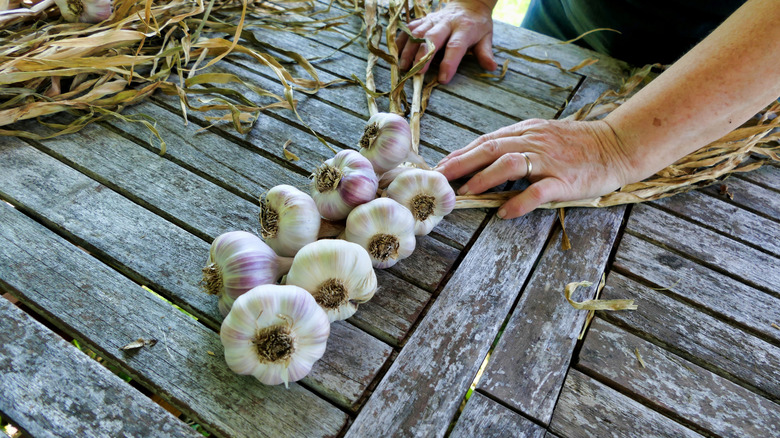Hardneck Vs Softneck Garlic: Which Would Grow Best In Your Garden?
You can never have enough garlic. It makes every meal better, and when stored properly, can last up to six months or more—making it worth the effort. Garlic also acts as pest control in your garden, so you can plant it strategically to maximize its benefits. The even better news is that garlic is a low-maintenance crop in almost any garden as long as you choose the right variety for your climate.
Garlic is planted in the fall, and once it's in the ground, you don't have to do much to care for it. Give it a bit of a boost in the spring with a little fertilizer, and wait for it to mature. However, if you're unfamiliar with growing garlic, you may not have realized it comes in two main varieties: hardneck (Allium sativum var. ophioscorodon) and softneck (Allium sativum var. sativum). As the names imply, hardneck garlic has a firm stalk, while softneck has a more flexible stalk. There are other differences, too. The cold-hardy, hardneck garlic typically has bigger cloves but fewer of them, while softneck garlic has many smaller cloves that form in warmer climates.
Chefs will also recognize different kinds of garlic have slightly different flavor profiles. Hardneck adds a more robust flavor to dishes, while softneck is more mild. But since the garlic you can grow in your garden has everything to do with your climate and nothing to do with personal preference, let's get down to it.
When to choose hardneck garlic for your garden
Is your garden covered with ice and snow all winter? Does the ground freeze? Then hardneck garlic is for you. If you live in a northern climate, not only will hardneck varieties survive, but they will thrive as they need cold exposure to grow. Without prolonged exposure to cold, known as vernalization, hardneck garlic will only produce a single, small bulb.
Even if you have the kind of winters where it's hard to imagine anything will grow, hardneck garlic will work for you, as it can survive down to Zone 0 as long as you give it a layer of mulch. Hardneck garlic does not store quite as well as its softneck counterparts, so it's critical to do it right. Trim the roots, cut the stalk just above the head, and then store it in a wire basket or mesh bag, hanging them to get good airflow, which is critical to keeping it fresh for as long as possible.
Hardneck garlic prefers well-drained soil rich with organic matter, and it's also worth noting that scapes — the edible flowering stems that so many foodies love — are only produced by this variety. It's also important to know why your garlic is flowering and what to do about it to ensure the best results.
When softneck garlic is right for your garden
If snow is practically a foreign concept and you can wear shorts in December, softneck garlic is a better bet for your garden. In contrast to its hardier cousin, softneck garlic loves the milder winters in Zones 8 through 12, but that does not mean it is a lost cause for those of you with tougher weather. Though temperate climates are ideal, softneck varieties can survive down to Zone 3 with a bit of extra mulch to protect them in the winter. So, those of you in the climate sweet spot may be able to grow both varieties.
Softneck garlic is known for being easier to store, lasting up to 9 months — you'll often see softnecks braided for storage — so if you can grow both varieties, you probably should. Well-drained soil in a sunny spot will ensure softneck varieties get off to a good start, and consistent watering will ensure a healthy bulb size.
Armed with this information and the knowledge of growing conditions in your area, you should be ready to narrow down your search and find the right garlic for your site. Despite its reputation for being a low-maintenance crop, there's still a lot you need to know about growing your own garlic. So keep learning!


